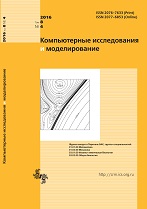|
ANALYSIS AND MODELING OF COMPLEX LIVING SYSTEMS
Survival task for the mathematical model of glioma therapy with blood-brain barrier
S. Yu. Kovalenkoa, G. M. Yusubalievab
a Federal Scientific and Clinical Center of FMBA of Russia,
Laboratory of Bioinformatics and Molecular Modeling,
Orehovuy boulevard 28, 115682, Russia
b First Moscow State Sechenov Medical University,
Trubetskaya st. 8/2, Moscow, 119992, Russia
Abstract:
The paper proposes a mathematical model for the therapy of glioma, taking into account the blood-brain barrier, radiotherapy and antibody therapy. The parameters were estimated from experimental data and the evaluation of the effectof parameter values on the effectiveness of treatment and the prognosis of the disease were obtained. The possible variants of sequential use of radiotherapy and the effect of antibodies have been explored. The combined use of radiotherapy within travenous administration of mab Cx43 leads to a potentiation of the therapeutic effect in glioma.
Radiotherapy must precede chemotherapy, as radio exposure reduces the barrier function of endothelial cells. Endothelial cells of the brain vessels fit tightly to each other. Between their walls are formed so-called tight contacts,whose role in the provision of BBB is that they prevent the penetration into the brain tissue of various undesirable substancesfrom the bloodstream. Dense contacts between endothelial cells block the intercellular passive transport.
The mathematical model consists of a continuous part and a discrete one. Experimental data on the volume of glioma show the following interesting dynamics: after cessation of radio exposure, tumor growth does not resume immediately, butthere is some time interval during which glioma does not grow. Glioma cells are divided into two groups. The first group isliving cells that divide as fast as possible. The second group is cells affected by radiation. As a measure of the health of theblood-brain barrier system, the ratios of the number of BBB cells at the current moment to the number of cells at rest, that is, on average healthy state, are chosen.
The continuous part of the model includes a description of the division of both types of glioma cells, the recovery of BBB cells, and the dynamics of the drug. Reducing the number of well-functioning BBB cells facilitates the penetration ofthe drug to brain cells, that is, enhances the action of the drug. At the same time, the rate of division of glioma cells does notincrease, since it is limited not by the deficiency of nutrients available to cells, but by the internal mechanisms of the cell. The discrete part of the mathematical model includes the operator of radio interaction, which is applied to the indicator ofBBB and to glial cells.
Within the framework of the mathematical model of treatment of a cancer tumor (glioma), the problem of optimal control with phase constraints is solved. The patient's condition is described by two variables: the volume of the tumor andthe condition of the BBB. The phase constraints delineate a certain area in the space of these indicators, which we call thesurvival area. Our task is to find such treatment strategies that minimize the time of treatment, maximize the patient's resttime, and at the same time allow state indicators not to exceed the permitted limits. Since the task of survival is to maximizethe patient's lifespan, it is precisely such treatment strategies that return the indicators to their original position (and we seeperiodic trajectories on the graphs). Periodic trajectories indicate that the deadly disease is translated into a chronic one.
Keywords:
the viability task, glioma therapy, mathematical model of the blood-brain barrier.
Received: 21.10.2017
Revised: 30.11.2017
Accepted: 11.12.2017
Citation:
S. Yu. Kovalenko, G. M. Yusubalieva, “Survival task for the mathematical model of glioma therapy with blood-brain barrier”, Computer Research and Modeling, 10:1 (2018), 113–123
Linking options:
https://www.mathnet.ru/eng/crm123 https://www.mathnet.ru/eng/crm/v10/i1/p113
|

| Statistics & downloads: |
| Abstract page: | 251 | | Full-text PDF : | 78 | | References: | 30 |
|




 Contact us:
Contact us: Terms of Use
Terms of Use
 Registration to the website
Registration to the website Logotypes
Logotypes








 Citation in format
Citation in format 